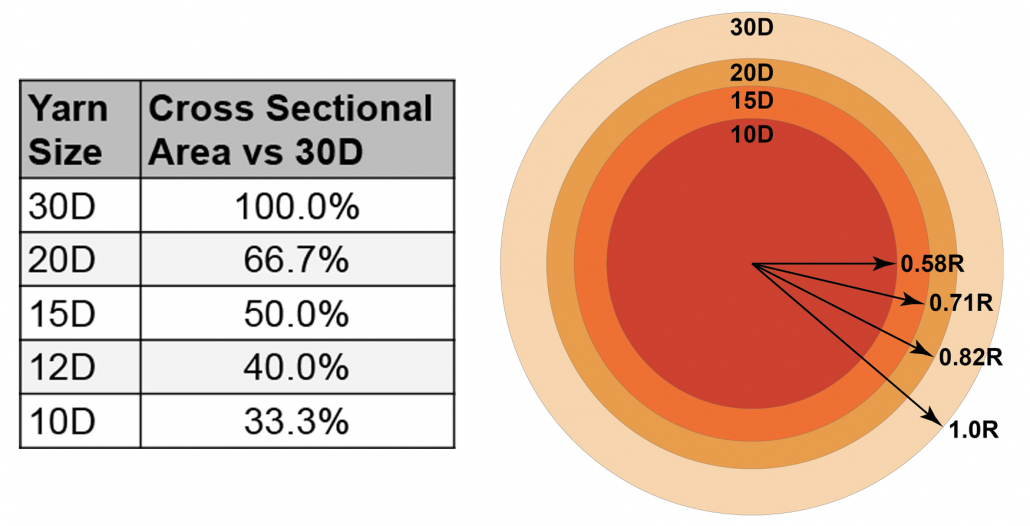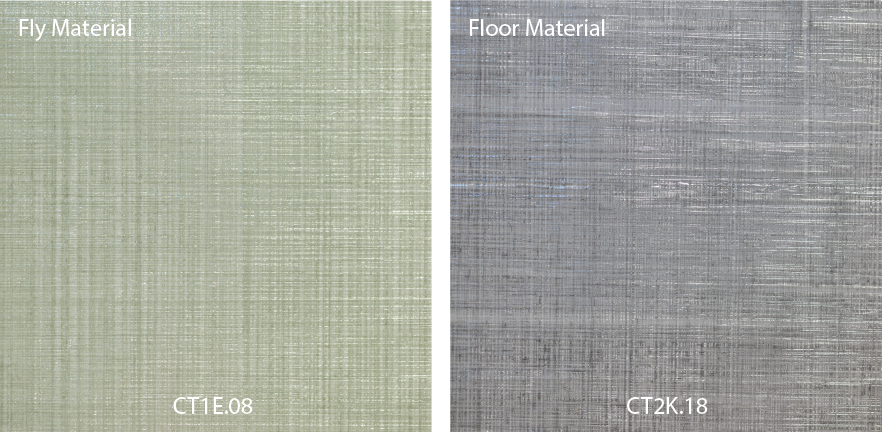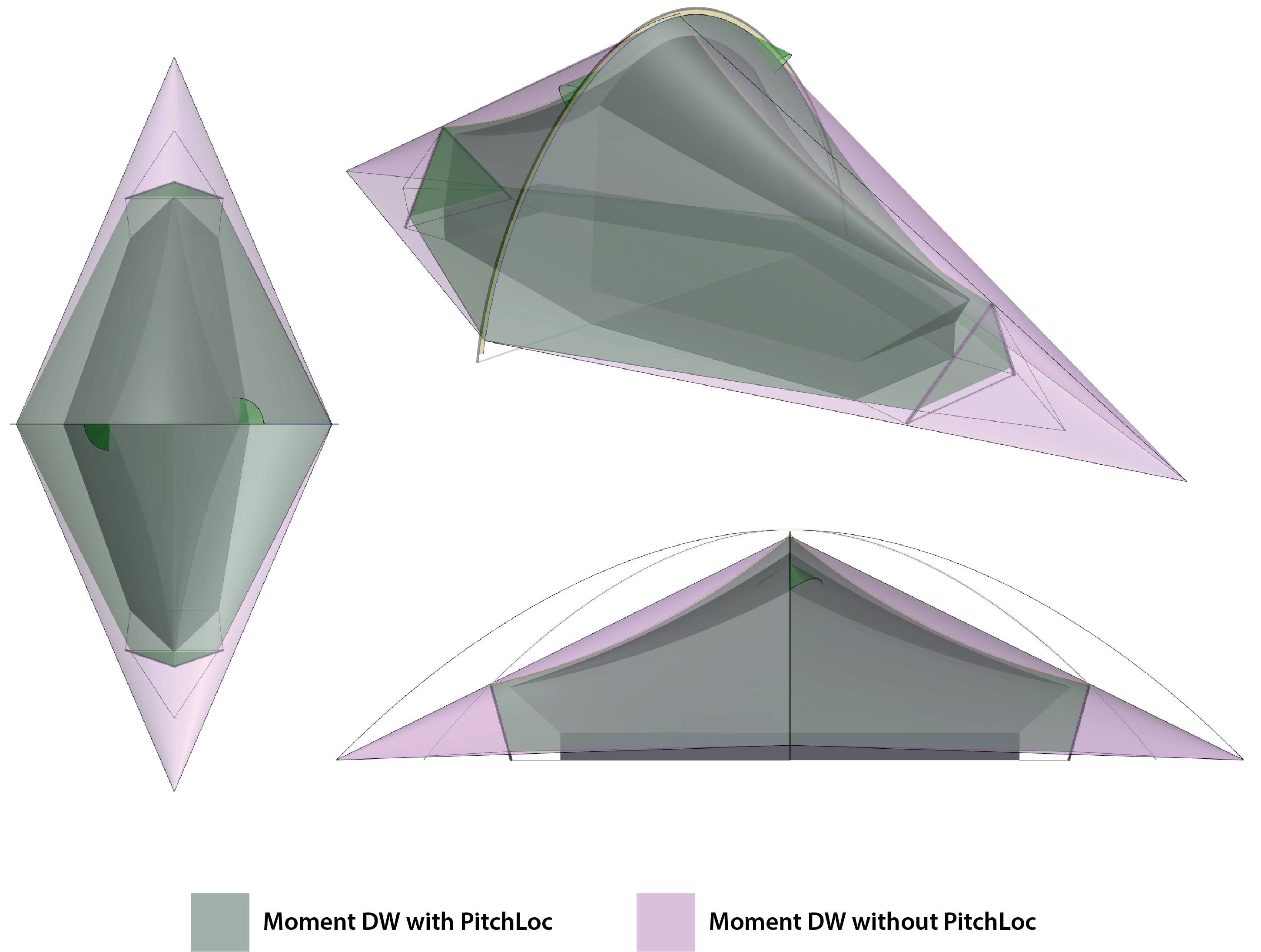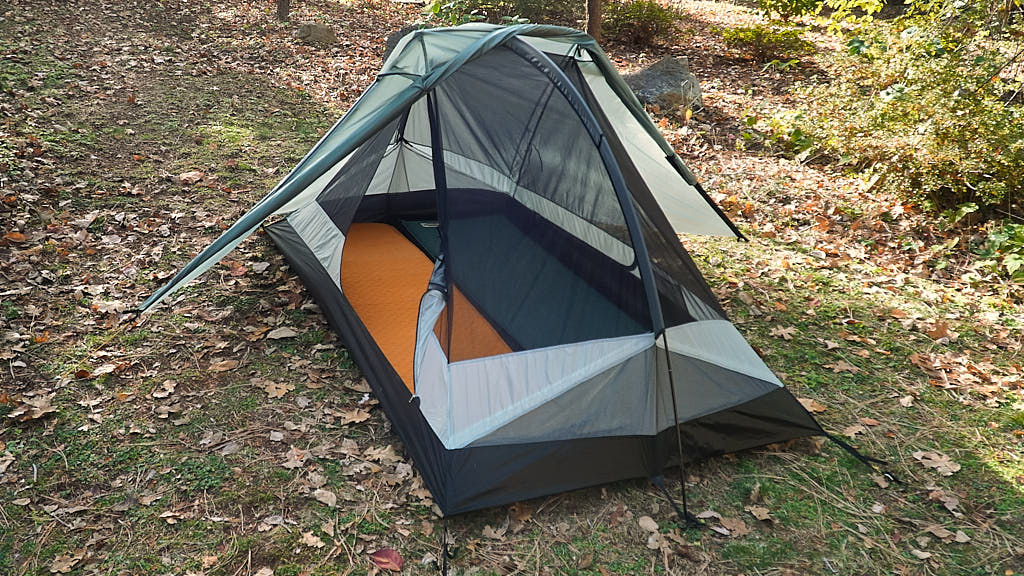Masterful designs.
Elegant solutions.
Though tents may seem like simple structures, Tarptents elegantly solve complex problems. Please read through the topics below to familiarize yourself with the tradeoffs and features present in different Tarptents.
Silicone Coated Nylon
Specifications:
30D Nylon 66 with Double Ripstop Grid
3000mm+ Hydrostatic Head
100% Silicone Coated, Both Sides
~1.5oz/yd
We utilize siliconized 30D ripstop nylons in all the floors of our non-Li series tents and many of the flys. We select sil-nylon with low stretch and good bias stability which gives dimensional stability and uniform deformation.
Nylon 66 offers the best strength to weight ratio available in traditional woven materials, but nylon expands and becomes more flexible when saturated with water leading to “sag” when it gets wet or humidity rises. We use this fabric for all of our non-Li series tent floors and in the flys of many of our tents due to its excellent strength and durability.
Silicone Coated Polyester
Specifications:
20D Polyester with Nano-Ripstop Grid
3000mm+ Hydrostatic Head
100% Silicone Coated, Both Sides
~1.4oz/yd
We utilize a siliconized 20D ripstop polyester in the flys of our polyester tents. This material offers weight savings, lower moisture adsorption, lower sag when wet, and better UV resistance compared to our silicone coated nylon. Tear and puncture resistance is lower than silnylon but with low stretch, good bias stability, and with some care taken to avoid puncture and abrasion this material is ideal for nearly all of our 3 and 3+ season tents. For tents with polyester flys we still use our 30D sil-nylon in the floors for its superior abrasion, tear, and puncture resistance.
Dyneema® Composite Fabrics (DCF)
CT1E.08:
Used in our Li series Flys
15,000mm or greater Hydrostatic Head
~0.55oz/yd
CT2K.18:
Used in our Li series Floors
20,000mm or greater Hydrostatic Head
~1.0oz/yd
What is DCF?
Our Lithium product line uses Dyneema® composite fabric (DCF), a laminate material made from ultra-high molecular weight polyethylene (UHMWPE) fibers and mylar film. Dyneema® is a brand name of these UHMWPE fibers which have a higher tensile strength than steel. When these fibers are laminated between films of mylar the result is an extremely light, strong, waterproof, and UV resistant material.
While DCF has tensile strength, tear strength, and hydrostatic head ratings which far surpass other tent materials it does have its own weaknesses. Notably, DCF has low abrasion resistance as the thin mylar film can wear away, eventually causing small “pinholes” in the material. To avoid the formation of these pinholes, hard creasing of DCF, which stresses the mylar film, should be avoided. Hence loosely rolling, and never stuffing, a DCF tent will help maximize its longevity. Because of this tendency for pinhole formation DCF has a lower life span than our silicone coated wovens and we expect DCF tents to last ~⅔ as long under similar use. That translates to something like 200 nights use compared to 300 nights in a sil-nylon tent.
DCF is also extremely low stretch which is an excellent property for tent materials, but leaves it more vulnerable to punctures. Where a fabric with stretch can deform around a pressure point to relieve stress, non-stretch fabrics like DCF do not leading to lower puncture resistance against small points like the end of a stick. Fortunately, DCF is also very easy to patch, and patch material is included with all our DCF tents.
Also unlike woven fabrics DCF will deform plastically, meaning that instead of springing back to its original shape it becomes permanently stretched out. This is not typically an issue as the stretch is extremely small, but this property is why we do not add guy line loops to the center of DCF tent panels. Using such loops deforms the DCF around the loop making the panel no longer flat, and once a panel is deformed in this way, it will not tension properly.
Dyneema® fiber and fabrics are made in Arizona.

Coatings and Seam Sealing
Why does my non-Li Series Tarptent need seam sealing?
We choose fabrics with 100% silicone coatings, and currently no usable seam tape exists for these coatings. This means that to seam seal the tent, liquid silicone must be ‘painted’ on by hand.
Li series tents do not need seam sealing as they are fully seam taped using PSA backed DCF tape from the factory.
To see how to seam seal click here.
Why 100% silicone coated fabrics?
Unlike any coating containing polyurethane (either polyester or polyether, often abbreviated as PU and PeU), 100% silicone coatings will never rot, yellow, or chemically decompose under normal conditions including hot humid environments. This means that the fabric’s coating will not limit the lifespan of the tent and does not require special care or storage specifically to preserve the coating. 100% Silicone coatings also increase the strength of the fabrics they are applied to, providing yet another benefit over PU coatings which actually decrease a fabric’s tear strength.
Do your fabrics have flame retardants?
No. Like many manufacturers these days we do not use fabric treated with flame retardant as any marginal safety benefits they may provide from fire is far outweighed by their toxicity to humans and the environment.
Usable Space
Why do some Tarptents have PitchLocs?
A critical design goal for every tent is to maximize usable volume. By usable volume we mean space into which you can reasonably sit up, lie down, change clothes, organize gear, read a book, etc. Listed lengths, widths, and height specifications mean little in the absence of understanding the tent’s geometry. Shallow sloping walls to ground can cut off usable volume, while steep slopes increase it. Two tents with identical floor dimensions and peak heights can have radically different usable volumes. For example PitchLoc ends are used in the Moment DW design to lift the effective height at the ends of the tent and dramatically increase usable floor length and volume without increasing the overall footprint.
Most people are about half their height when they are sitting up, and for your footbox, a good height estimate is 12 inches, or 30 cm. When looking at a tent, think about where your head feet are going to be and how high the ceiling is at that point. This is where a listed floor dimensions can be deceiving if the tent canopy drops below a comfortable height before the floor ends.
Detailed dimensions for all our shelters can be found on their product pages. We also have fly-arounds of 3D models with 6 ft (183cm) tall human models inside them to help you visualize how it might feel for you to be inside.
Why choose Front or Side Entry?
A front entrance shelter usually has one entrance by your head. A double-side entrance shelter has an entrance on either side of your body. Shelters with only one entrance tend to be lighter (less fabric and less zipper), while a double-side entrance shelter is generally easier to enter and exit, provides better ventilation, and provides more vestibule space. In multi-person tents having more than one entry/exit can also help prevent disturbing your companion(s) when entering or exiting the tent.

What is a freestanding tent?
It depends on who you ask but in the strictest sense a freestanding tent is one that can be fully pitched using no stakes or external anchor points. Many people (especially in the United States) include tents that require stakes for vestibules only when talking about “freestanding” tents.
The benefits of freestanding tents are that they can be pitched anywhere, but of course without any stakes to hold it to the ground, nothing but the weight inside will prevent the tent from being blown away in wind. Thus freestanding tents still require stakes/anchors for full performance in wind which can then make that fact that the tent is fully freestanding mostly redundant.
What is a non-freestanding (stake supported) tent?
A non-freestanding tent is one that has little to no structure without staked/anchored points. A classic non-freestanding tent is our Stratospire series, as without staked/anchored points these tents have little inherent structure. Most trekking pole supported tents are non-freestanding.
The obvious reasons for choosing a non-freestanding tent is weight and packed size. Rigid or semi-rigid structural parts add weight and bulk to a tent, but non-freestanding also means that more careful campsite selection is needed and usable interior space is decreased for a given footprint. Non-freestanding tents also generally require a longer and more careful set-up.
What is a semi-freestanding tent?
A semi-freestanding tent is one that is not strictly freestanding and not strictly non-freestanding. This means the tent does require staked/anchored points for set up, but it also has some inherent structure of its own such as an arch pole.
This is often a happy medium as it means increased usable space, wider campsite choice, and decreased overall footprint compared to a non-freestanding tent. And when compared to fully freestanding tents, semi-freestanding designs typically offer significantly lower weight and bulk.
Why do some Tarptents have optional crossing poles?
Most of our tents are non-freestanding or semi freestanding in their basic set up mode. Tents like the Moment DW and the Scarp series offer the option to use additional crossing poles. These additional poles allow the tent to convert from semi-freestanding to freestanding at the cost of the extra pole weight. These additional poles also allow the tent to be used in high wind and heavy snow conditions as they are designed to provide additional structure and support.
Why Pole Sleeves and not Pole Clips?
Pole sleeves provide uniform tension across the entire sleeve rather than at a few single points. This means more space inside for a given arch shape/size as the tent panels can closely match the arch shape rather than being forced to span a few points below it. Distributing the tension from the arch pole also means less stress on the tent fabric compared to concentrating the stress on a few clipped points.
Arch sleeves also offer convenient set up and take down as there are not a series of clips to do and undo each time. Sleeves also allow for easy “fly first” set-up which is essential if you want to keep the interior of the tent dry when setting up in the rain.
What is a double wall tent?
A double wall tent is one where two layers of material separate the inside of the tent from the outside world. This is typically a waterproof fly over a mesh or breathable solid fabric interior.
There are a few main advantages to double wall tents. One is that if condensation forms on the underside of the fly you are separated from accidentally touching it by a layer of material. Another is versatility. For example our Stratospire tents can be used with a mesh interior in warmer weather, with a solid interior in colder weather, with no interior as just a tarp, or as only an interior in fair weather.
What is a single wall tent?
A single wall tent is one where only a single layer of material separates the inside of the tent and the outside world.
The advantage of a single wall tent is weight and simplicity. Why carry two layers of material when you only really need one? Single wall tents like the Protrail still offer the same bug and weather protection as a double wall tent but do not separate the user from potential condensation and do not offer the versatility of set-up options like a double wall.
What is a Hybrid Single-Double Wall Tent?
A hybrid single double wall tent is one that is like a single wall tent but with features that perform like a double wall. For example the Double Rainbow can be used with a liner to separate the user(s) from condensation like in a double wall tent.
The advantage of this type of design is that it retains much of the weight savings and simplicity of a single wall while providing some of the benefits of a double wall.
Which to Choose?
The often misunderstood fact about single versus double wall tents is condensation. Condensation occurs when warm air settles on cold surfaces. Moisture released as you breathe can become condensation as can moisture present in ambient air. Humans exhale about 16 fluid oz / 0.5 liters of water every night and all that moisture has to go somewhere. We make both single and full double wall shelters (all of which are fully enclosed) but there’s no magic about a double wall. All tents condensate. What ultimately matters is whether or not the condensation gets on you and/or your gear. Proper site selection can make all the difference between lots of condensation and little, if any, condensation. Our “How to minimize condensation” video is listed below and well-worth watching.
If you are worried about condensation because your intended use is in cool damp environments, we recommend a double wall. Additionally, if you desire a more versatile tent for a variety of conditions choosing a double wall gives you more set-up options.
If you want to go fast and light or just prefer a less complicated and more minimal shelter a single wall is for you. In many conditions a single wall will perform identically to a double wall but at a lower weight.
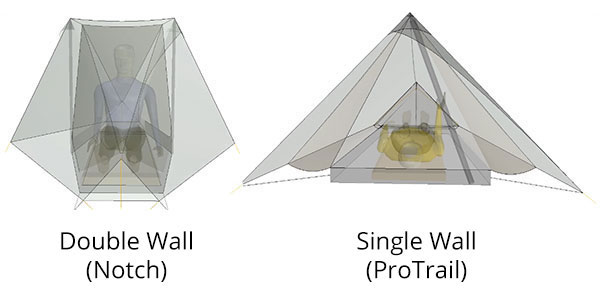
Tent Weight
How weight is typically measured – MSR’s Tent Weight Page
All of the weights listed for tents take into account the stakes, poles, stuff sacks, and guylines for the tent. Basically, everything you’ll need out on the trail/ water/ road/ adventure. When you’re comparing tent weights, don’t forget to take into account the weights of any groundsheet, extra stakes, vertical support poles, or crossing poles
In our product line, a tent that is a single wall, single door, trekking pole supported shelter will be lighter than the converse (a double wall, double side entrance, arch pole supported shelter). Consider these tradeoffs as you search for the best solution to your needs.
Another important consideration is the tent’s weight per person. Single person tents will inherently have a higher weight per person regardless of design or materials. This is well demonstrated by our four person Hogback which comes in at 15.75oz/person which is lower even than the Protrail Li at 17.7oz/person.
Tarptent
12213 Koswyn Ct.
Nevada City, CA 95959 USA
Phone:
650-587-1548
530-362-8763


